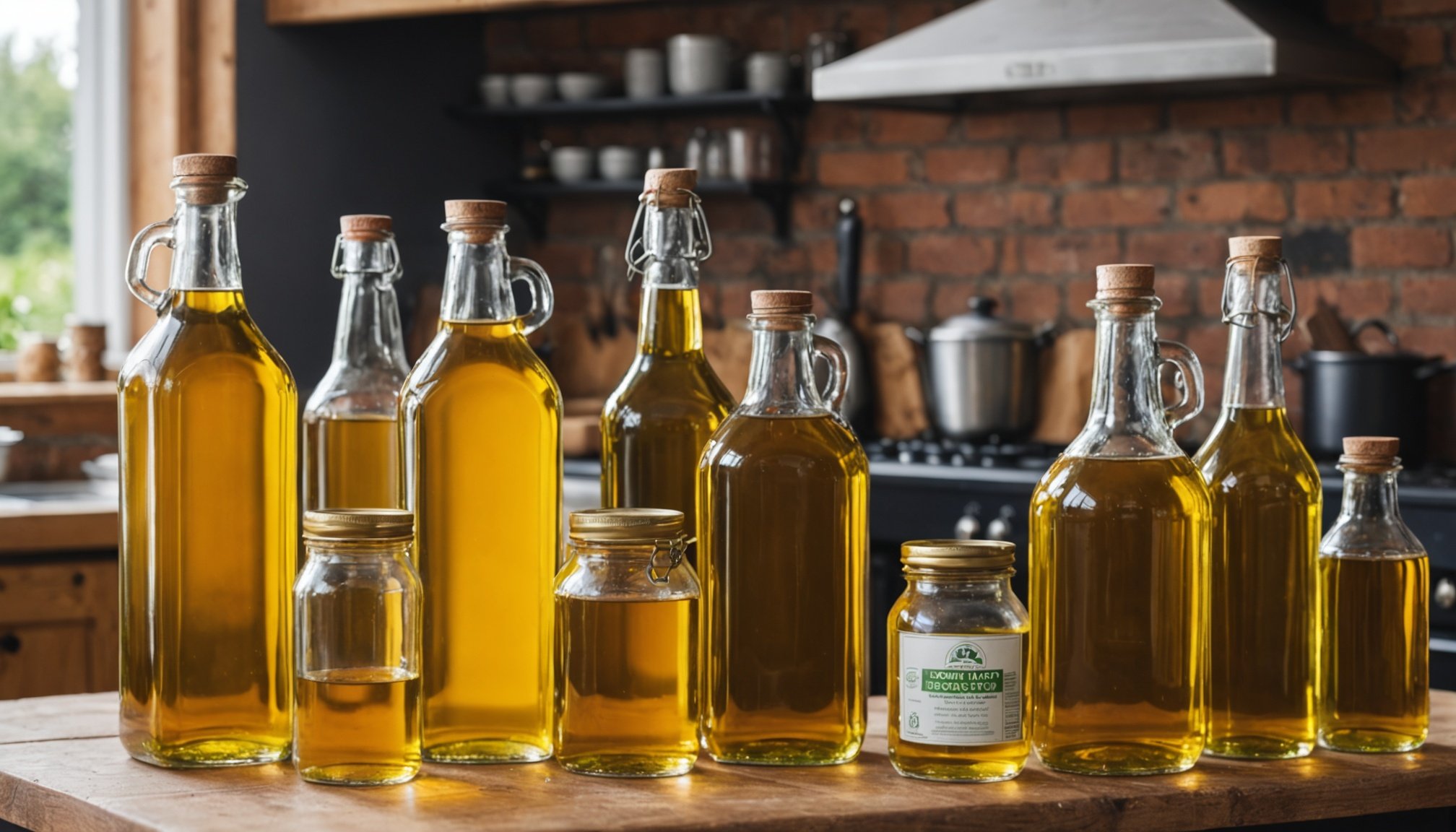Overview of Cooking Oil Disposal in the UK
Cooking oil disposal in the UK is a significant concern due to its environmental impact and relevance to public health. Proper disposal methods ensure that oils don’t seep into water supplies or clog drainage systems. The UK has established strict regulations regarding cooking oil disposal, emphasizing its importance. These regulations not only aim to safeguard the environment but also prevent potential health hazards.
Failing to adhere to the UK regulations can lead to severe ecological consequences. Improper disposal of cooking oil can cause blockages in sewage systems, often referred to as “fatbergs.” These can result in costly repairs and environmental degradation. Furthermore, incorrect disposal methods can harm wildlife and contribute to pollution.
In the same genre : Discover stylish jewelry box selections tailored for your needs
For individuals and businesses, understanding these methods is crucial. It helps in avoiding fines and contributing positively to environmental sustainability. By following the guidelines set forth, the public can significantly reduce negative impacts. It is essential to stay informed about proper disposal practices and utilize available resources to aid in the process. This approach not only benefits the individual but also supports broader environmental and societal health.
Methods for Cooling and Storing Used Cooking Oil
Handling used cooking oil safely is crucial before considering disposal or recycling options. First, let the oil cool to room temperature. This prevents burns and minimises the risk of splattering. To aid in cooling used oil effectively, simply leave it uncovered in a well-ventilated area or use a wide container to speed up the process. Never rush the cooling, as it might lead to unsafe handling.
Also to discover : Shop the best jewelry box options for every style and need
Once cooled, storing the oil properly is the next step. Use recommended containers such as glass jars, metal cans, or dedicated oil storage solutions made of sturdy materials. Seal these containers tightly to prevent spillage or contamination. It’s vital to clearly label each container with the storage date and specific oil type for future reference.
To avoid contamination during storage, always ensure that the containers are clean and dry before filling them with oil. Keep the stored oil in a cool, dark place away from direct sunlight. By doing so, the quality of the oil is less likely to degrade, making it safer for eventual disposal or recycling options. Implementing these practices contributes to a safer and more environmentally responsible approach.
Eco-Friendly Disposal Options for Cooking Oil
Embracing eco-friendly disposal practices for cooking oil can substantially enhance both environmental and public health. One sustainable method involves recycling cooking oil, which can be transformed into biodiesel—a cleaner fuel alternative.
Another greener alternative is organic waste management. Contributing your used oil to a local composting facility helps reduce waste and enriches the compost with valuable nutrients.
When considering recycling, knowing how to find local options is key. Many UK cities provide access to recycling centres equipped to process used cooking oil. Typically, these facilities convert the oil into energy, providing a practical solution to energy sustainability.
A significant benefit of recycling cooking oil is its ability to protect water systems. Proper disposal prevents oils from seeping into waterways, reducing pollution and safeguarding aquatic life. This also mitigates the strain on sewage and drainage systems, cutting down the occurrence of dreaded “fatbergs.”
By participating in recycling initiatives, individuals contribute towards a cleaner environment while supporting local efforts in creating renewable energy sources. Remember, embracing eco-friendly disposal not only benefits the planet but also plays a part in a more sustainable future.
DIY Recycling Ideas for Used Cooking Oil
Discovering creative uses for used cooking oil at home not only helps the environment but can also be a fun and rewarding process. With a bit of creativity, you can turn kitchen waste into valuable products.
One innovative way to repurpose used cooking oil is by making homemade soap. By mixing the oil with lye and fragrance, you can create a personalised product that is not only cost-effective but also unique. Similarly, used oil can be transformed into candles, providing a cosy ambience with a touch of personal flair.
For those keen on DIY, creating a biodiesel setup might be an exciting challenge. Although more complex, this process converts used oil into fuel, offering potential savings and the satisfaction of being self-sufficient.
Step-by-step guides for these projects are readily available online, offering detailed instructions to ensure your success. Not only do these projects repurpose oil, but they also promote sustainability and cost savings.
By exploring repurposing oil, individuals help reduce waste while enjoying the rewards of creative endeavours. Engaging in DIY recycling can be a delightful adventure, sparking interest in environmentally-friendly practices.
Local Recycling Programs and Resources
Delving into local recycling programs can be a game changer for environmentally-conscious individuals and businesses. Many UK communities offer initiatives that simplify cooking oil disposal, contributing to the environmental impact reduction.
To locate these programs, residents can start by checking their local council’s website, which typically features a dedicated section for waste management. Councils often collaborate with recycling centres to make the process seamless. It’s advisable to contact these centres directly to learn about specific procedures and accepted materials.
Additionally, several non-profit organisations run regional collection drives for used cooking oil. These community initiatives might offer designated drop-off points or even scheduled pick-up services, making participation effortless.
For those eager to extend their impact, consider engaging with social media groups focusing on community initiatives. These platforms provide updates about new recycling efforts and connect like-minded individuals. Joining forces can lead to more effective solutions and wider participation.
Remember, cooperating with local councils and recycling programs not only aids waste management but also underscores the collective effort towards a sustainable future. With the right resources and community support, proper disposal becomes a straightforward part of everyday life.
Safety Tips for Handling Cooking Oil
Cooking oil can be a kitchen hazard if not managed properly. Understanding safety tips is crucial to prevent spills and accidents, which can lead to injuries. Firstly, it’s essential to ensure a clear and clutter-free cooking space. This minimizes tripping risks and allows for swift movement when dealing with hot oil. Use non-slip mats to ensure stability in the kitchen.
Wearing appropriate safety equipment is vital. An apron, heat-resistant gloves, and closed-toe shoes can offer significant protection during cooking. Always use a thermometer to monitor oil temperature, avoiding overheating which can result in dangerous oil splatters.
In the unfortunate event of a spill, knowing how to clean up safely is essential. Immediately douse oil spills with a generous layer of baking soda or cornstarch. This absorbs the oil, making cleaning easier and reducing slip risks. Alternatively, use a commercially available oil-absorbent pad designed for rapid cleanup.
Lastly, have a proper fire extinguisher, specifically a Class K type, nearby when frying to effectively handle oil fires. Understanding these safety precautions, and adhering to them, can significantly reduce kitchen hazards associated with cooking oil.
Visual Aids and Resources for Cooking Oil Disposal
Visual aids play an integral role in comprehending disposal methods for cooking oil. They simplify complex processes, making it easier for individuals to understand the steps involved in safe disposal. When grappling with disposal guidelines, visual representation can significantly enhance clarity and retention.
Numerous resources and informative guides are available online to aid in grasping cooking oil management. These guides often incorporate step-by-step illustrations or short instructional videos, catering to visual learners. They provide concise information, ensuring users follow correct protocols effectively.
Infographics, in particular, serve as a powerful tool to streamline the disposal process. By detailing each stage visually, they can help demystify the regulations and procedures involved in cooking oil disposal. Infographics often use vivid graphics to depict actions like cooling, storing, or disposing, making adherence to practices both straightforward and memorable.
When utilising these resources, individuals can refer to online platforms dedicated to waste management education. These sites typically offer downloadable guides, engaging instructional imagery, and collaborative forums for advice. Embracing such visual aids ensures that the journey towards responsible oil disposal is both accessible and informed.



